You searched for: "WOMEN IN THE RESISTANCE"
<< Previous | Displaying results 51-75 of 174 for ""WOMEN IN THE RESISTANCE"" | Next >>
-
Brenda Senders in Rovno
PhotoBrenda Senders in Rovno, 1944. Brenda joined a partisan unit that was constantly on the move. It occupied villages, conducted ambushes, shot passing German troops, blew up bases, and obliterated bridges and train tracks.

-
Haviva Reik
Media EssayHaviva Reik was one of 32 Jewish parachutists from Palestine who volunteered to join the British army and infiltrate German-occupied Europe. Reik was sent to Slovakia on a mission to aid Jews during the Slovak nationa...
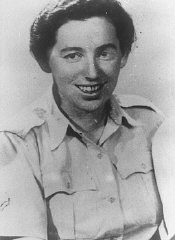
-
Jewish parachutist Haviva Reik before her mission to aid Jews in Slovakia
PhotoPhotograph of Jewish parachutist Haviva Reik taken before her mission to aid Jews in Slovakia during the Slovak national uprising. Palestine, before September 1944.
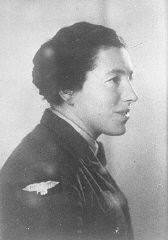
-
1945 portrait of Eta Wrobel
Photo1945 portrait of Eta Wrobel who was born on December 28, 1918, in Lokov, Poland. During the Holocaust, Eta helped organize an exclusively Jewish partisan unit of close to eighty people. She was the only child in her family of ten to survive.
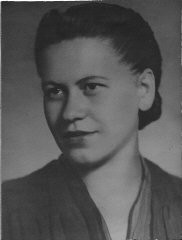
-
Frieda Belinfante
Photo“For three months I was disguised as a man, and very successfully… I passed my mother several times … she never recognized me.” Frieda Belinfante, a half-Jewish lesbian, used this disguise to hide from Nazi authorities. In a later interview she said, “I really looked pretty good.” Her involvement in the resistance movement included planning the destruction of the Amsterdam Population Registry in March 1943, falsifying identity cards, and arranging hiding places for those who were sought by…
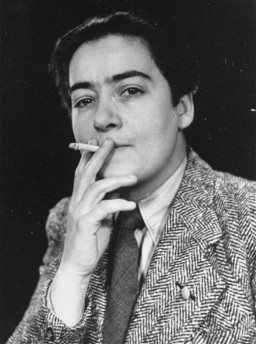
-
Rachel Mutterperl Goldfarb describes how partisans obtained weapons from German soldiers
Oral HistoryThe Germans established a ghetto in Dokszyce in late 1941. Rachel hid during the liquidation of the ghetto in 1942, and she and her mother escaped to another ghetto. When the second ghetto was about to be liquidated, they escaped again. Rachel and her mother joined a band of partisans in the forest. She helped her mother to cook, and also cleaned weapons. Rachel and her mother tried to leave Europe when the war ended. They eventually arrived in the United States, in 1947.

-
Minsk - Photographs
Media EssayGerman authorities established a ghetto in Minsk in July 1941, shortly after German forces occupied the city. About 80,000 Jews were initially crowded into the ghetto, with 24,000 more people deported there later that year. In August 1941, the Germans began mass killing operations against the residents of the ghetto.
-
Prisoner Revolt at Auschwitz-Birkenau
Timeline EventOctober 7, 1944. On this date, the Sonderkommando working at Crematorium IV in Auschwitz-Birkenau rose in revolt.
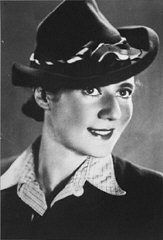
-
Danuta Justyna
ID CardDanuta was born to Roman Catholic parents in the small industrial town of Piotrkow Trybunalski in central Poland. Her father and mother were school teachers. She and her younger sister, Maria, became friends with two Jewish girls, Sabina and Helena Szwarc. Although their houses were more than a mile apart, the girls often played together. 1933-39: Danuta was planning on attending college in September 1939, but on September 1 Germany invaded Poland. Four days later, German soldiers streamed into Danuta's…
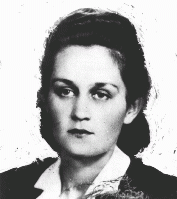
-
Alisa (Lisa) Nussbaum Derman describes partisan activities
Oral HistoryLisa was one of three children born to a religious Jewish family. Following the German occupation of her hometown in 1939, Lisa and her family moved first to Augustow and then to Slonim (in Soviet-occupied eastern Poland). German troops captured Slonim in June 1941, during the invasion of the Soviet Union. In Slonim, the Germans established a ghetto which existed from 1941 to 1942. Lisa eventually escaped from Slonim, and went first to Grodno and then to Vilna, where she joined the resistance movement. She…
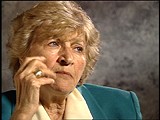
-
Maria Justyna
ID CardMaria was born to Roman Catholic parents in the industrial town of Piotrkow Trybunalski in central Poland. Her father and mother were school teachers. Maria attended grade school and secondary school in Piotrkow. She and her older sister, Danuta, became friends with two Jewish girls, Sabina and Helena Szwarc. Although their houses were more than a mile apart, the girls often played together. 1933-39: The Germans invaded Poland on September 1, 1939, and occupied Piotrkow four days later. Most schooling for…
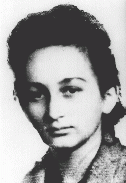
-
The Council for Aid to Jews: Żegota
Media EssayThe Council for Aid to Jews (codenamed “Żegota”) was an underground rescue organization of Poles and Jews. It operated in German-occupied Poland from December 4, 1942, to January 1945 and was supported by the Polish government-in-exile. Żegota’s main objective was to coordinate efforts to save Jews from Nazi persecution and murder. Its members worked clandestinely, often risking their own lives and the lives of their families and friends. Żegota supplied tens of thousands of Polish Jews with fake…
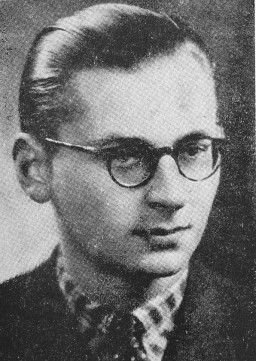
-
Irena Elzbieta Wos
ID CardIrena was the second of four children born to religious Roman Catholic parents in Poland's capital of Warsaw. Irena's father owned a successful textile business. When Irena was 10, her family moved to a comfortable apartment near the Royal Castle and the Vistula River. In 1930 Irena entered a private grade school. 1933-39: At 14 Irena began secondary school. She was a good student and wanted to be a doctor. On September 1, 1939, the day she was supposed to begin the new school year, the Germans attacked…

-
Hannah Szenes in Budapest
PhotoHannah Szenes, in the garden of her Budapest home before she moved to Palestine and became a parachutist for rescue missions. Budapest, Hungary, before 1939.

-
Dora Rivkina
ID CardDora was the second of three girls born to a Jewish family in Minsk, the capital of Belorussia. Before World War II, more than a third of the city was Jewish. Dora and her family lived on Novomesnitskaya Street in central Minsk. Dora's father worked in a state-owned factory building furniture. 1933-39: As a young girl, Dora was athletic and excelled at swimming and dancing. When she was in the second grade, she was chosen to dance the lead part in a New Year's performance. She was also a member of the…
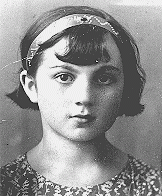
-
Jewish Parachutists from Palestine - Photographs
Media EssayBetween 1943 and 1945, a group of Jewish men and women from Palestine parachuted into German-occupied Europe. The 32 parachutists had volunteered with the British army and were sent on rescue and resistance missions. The Germans captured 12 of the...
-
Magdalena Kusserow
ID CardOne of 11 children, Magdalena was raised as a Jehovah's Witness. When she was 7, her family moved to the small town of Bad Lippspringe. Her father was a retired postal official and her mother was a teacher. Their home was known as "The Golden Age" because it was the headquarters of the local Jehovah's Witness congregation. By age 8 Magdalena could recite many Bible verses by heart. 1933-39: The Kusserow's loyalty was to Jehovah, so the Nazis marked them as enemies. At 12 Magdalena joined her parents and…

-
Vladka (Fagele) Peltel Meed describes smuggling activities in the Warsaw ghetto
Oral HistoryVladka belonged to the Zukunft youth movement of the Bund (the Jewish Socialist party). She was active in the Warsaw ghetto underground as a member of the Jewish Fighting Organization (ZOB). In December 1942, she was smuggled out to the Aryan, Polish side of Warsaw to try to obtain arms and to find hiding places for children and adults. She became an active courier for the Jewish underground and for Jews in camps, forests, and other ghettos.
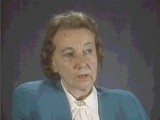
-
Frank Blaichman (Jewish Partisan Educational Foundation biography)
ArticleRead the Jewish Partisan Educational Foundation's short biography of Frank Blaichman.
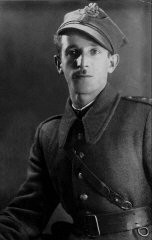
-
Sobibor Uprising
Timeline EventOctober 14, 1943. On this date, Jewish prisoners started an uprising at the Sobibor killing center, which Selma Wijnberg and Chaim Engel escaped.
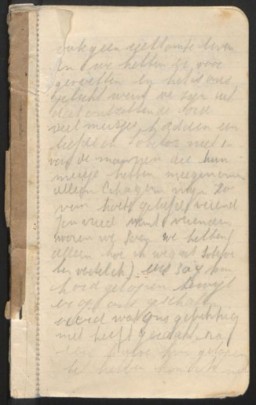
-
Personal Stories: Jewish Partisans
ArticleBrowse a series of short biographies from the Jewish Partisan Educational Foundation.

-
Vladka (Fagele) Peltel Meed describes reactions after the Warsaw ghetto uprising
Oral HistoryVladka belonged to the Zukunft youth movement of the Bund (the Jewish Socialist party). She was active in the Warsaw ghetto underground as a member of the Jewish Fighting Organization (ZOB). In December 1942, she was smuggled out to the Aryan, Polish side of Warsaw to try to obtain arms and to find hiding places for children and adults. She became an active courier for the Jewish underground and for Jews in camps, forests, and other ghettos.
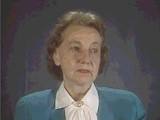
-
Hannah Szenes
Media EssayHannah Szenes (Senesh) was one of 32 Jewish volunteer parachutists from Palestine that the British Army sent behind German lines for resistance and rescue efforts. On June 7, 1944, Szenes infiltrated German-occupied Hungary. The Germans captured h...
